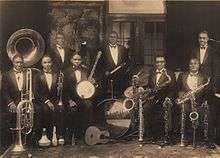Red Perkins
| Red Perkins | |
|---|---|
| Birth name | Frank Shelton Perkins |
| Born |
December 26, 1890 Muchakinock, Iowa United States |
| Died |
September 27, 1976 (aged 85) Minneapolis, Minnesota United States |
| Genres |
Jazz music Big band |
| Occupation(s) |
Bandleader Musician |
| Instruments | Trumpet |
| Labels | Gennett Records |
| Associated acts | Red Perkins and His Dixie Ramblers |
Frank Shelton "Red" Perkins (December 26, 1890 – September 27, 1976)[1][2] was an African-American 1920s and 1930s era trumpet player, singer, and a bandleader of one of the oldest Omaha, Nebraska-based jazz territory bands, The Dixie Ramblers.[3]
Early life
Perkins was born in Muchakinock, Iowa, a coal mining camp near Oskaloosa, Iowa. As an adult, Perkins moved from Oskaloosa to Fort Dodge, Iowa.
In 1917, Perkins moved with his wife and child to Omaha, Nebraska. He got a job as a porter at a barber shop and worked there from 1917 to 1925.[3]
Career

In 1923, Perkins took over the Omaha Night Owls jazz band and renamed them the Dixie Ramblers. Perkins based his band in Omaha's Near North Side. It was a small band with six players but several of the musicians doubled on different instruments. The Dixie Ramblers quickly grew into a medium-sized jazz territory band.[4]
The National Orchestra Service booked the band from 1923 into the 1940s. In 1932, he joined with harmonica player O.P. Alexander and they performed on radio station WFAA until 1934. Perkins and his band were signed by RCA Victor in 1936 and later released music on Gennett Records. The band cut more than 250 sides of records. The band played in ballrooms, theaters, and hotels in Nebraska, Iowa, Kansas, South Dakota, and North Dakota.[3]
One of the Dixie Rambler's most famous songs was "Hard Times Stomp."[5] The jazz band was known for its variety acts and floor shows.[6]
Perkins' bookings were handled by National Orchestra Service of Omaha, Nebraska.[7]
Personal life
Towards the end of the big band era in the late 1940s, Perkins moved to Minneapolis, MN and became a professional photographer. He died September 27, 1976 in Minneapolis, Minnesota.[4]
Selected discography
During the 1920s and 1930s, the Dixie Ramblers recorded for Gennett Records.
- Red Perkins and His Dixie Ramblers
- Frank "Red" Perkins (t,as,ss,v) dir. Joe Drake (t,cl,ts,arr), Andre C. Oglesby (tb), Jesse Simmons (cl,as,ts), Howard Fields (p), Charles “Goodie” Watkins (bjo, gtr), Eugene Freels (t, bb), Harry Rooks (d-x), trio (v).
- Richmond, Ind., May 5, 1931
- 17727-A Hard Times Stomp (Perkins) Ch 40044
- 17728-A My Baby Knows How (Davis-Akst-Richman) -vFP Ch 16661
- Richmond, Ind., May 6, 1931
- 17729-A Old Man Blues (Paul, Ellington, Mills) - v3 Ch 40044
- 17730 Minor Blues (Perkins) Ch 16288
Members of The Dixie Ramblers
- Anna Mae Winburn, singer
- Bill Osboen
- Charlie "Big" Green, trombone
- Charlie Watkins
- Harry Fooks
- Jabbo Smith, trumpet
- Jay Green
- Jim Alexander
References
- ↑ "Frank S. Perkins - Minnesota Death Index". FamilySearch. Retrieved 20 February 2016.
- ↑ "Frank Perkins - United States Social Security Death Index". FamilySearch. Retrieved 20 February 2016.
- 1 2 3 Breaux, Richard M. (2012). "The New Negro Renaissance in Omaha and Lincoln, 1910-1940". In Glasrud, Bruce A.; Wintz, Cary D. The Harlem Renaissance in the American West: The New Negro's Western Experience. New York: Routledge. pp. 125–126. ISBN 978-1-136-64911-0. OCLC 784953356. Retrieved 20 February 2016.
- 1 2 Walker, Leo (1989). The Big Band Almanac (Revised ed.). New York, N.Y.: Da Capo Press. pp. 340–341. ISBN 978-0-306-80345-1. OCLC 18873553. Retrieved 20 February 2016.
- ↑ Schuller, Gunther (1986). "The Territory Bands". The Swing Era: The Development of Jazz, 1930-1945. New York: Oxford University Press. p. 787. ISBN 978-0-195-07140-5. OCLC 25637133. Archived from the original on 20 February 2016. Retrieved 20 February 2016.
- ↑ "The Dixie Ramblers". History Harvest: Great Plains Black History Museum. University of Nebraska, Lincoln. Retrieved 20 February 2016.
- ↑ Lee, William F. (2005). American Big Bands (1st ed.). Milwaukee, Wis.: Leonard. p. 93. ISBN 978-0-634-08054-8. OCLC 62090862. Retrieved 20 February 2016.
External links
- Red Perkins discography at Discogs